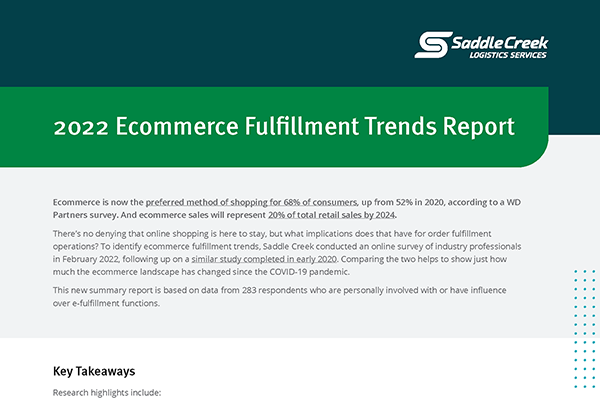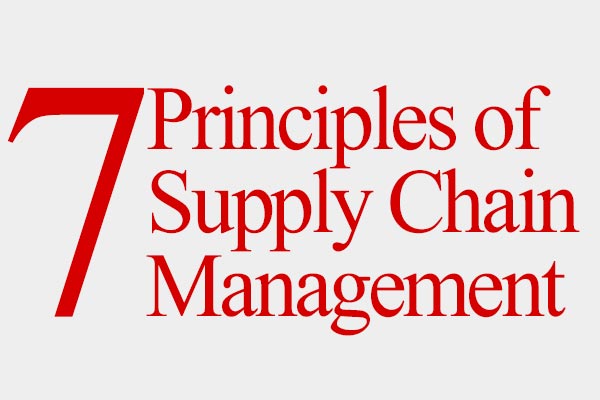2022 Ecommerce Fulfillment Trends Report
Ecommerce growth has transformed the order fulfillment landscape. This research-based report explores how retailers and brands are solving top operational challenges involving space, labor, technology, shipping and more.
Ecommerce is now the preferred method of shopping for 68% of consumers, up from 52% in 2020, according to a WD Partners survey. And ecommerce sales will represent 20% of total retail sales by 2024.
There’s no denying that online shopping is here to stay, but what implications does that have for order fulfillment operations? To identify ecommerce fulfillment trends, Saddle Creek conducted an online survey of industry professionals in February 2022, following up on a similar study completed in early 2020. Comparing the two helps to show just how much the ecommerce landscape has changed since the COVID-19 pandemic.
Following is an excerpt from the full report…
Solving Top Fulfillment Challenges
Survey respondents faced a litany of fulfillment challenges in the past year. The top five were delivery expectations, transportation capacity, the labor shortage, warehouse space and technology limitations.
Following is an examination of each of these issues and how companies are addressing them.
Shipping
Record ecommerce order volume, combined with rising rates and capacity issues, made shipping particularly challenging this year. Not surprisingly, delivery expectations (45%) and transportation capacity (36%) were the most common fulfillment challenges.
To help mitigate transportation issues, shippers are utilizing traditional strategies such as negotiating rates (36%) and switching carriers (31%), but they are also exploring a variety of other approaches.
Many respondents are turning to technology. Approximately half (48%) are adding or upgrading their parcel/LTL transportation management system (TMS) while 36% are automating parcel sortation, and/or utilizing software for rate shopping (32%) and parcel analytics (29%).
Belcastro approves. “It’s a seller’s market for carriers, and you’re most likely to control costs by shipping smarter,” he says. “You need to use every tool at your disposal to increase efficiency and optimization.”
While fewer companies are leveraging consolidation (27%) and zone skipping (21%), Belcastro points out that these strategies can help to provide savings in parcel costs and/or transit time. When high order volume is expected for a specific area, it may make sense to bulk ship orders to a carrier’s regional induction point.

Labor
The labor shortage had a significant impact on the vast majority of fulfillment operations in the past year. An overwhelming 77% of respondents say that it has affected their operations in some way.
As noted earlier, the cost impact stood out, in particular. More than half (59%) of all respondents say that their labor costs increased in the past year as a result of the shortage.
Customer experience also appeared to suffer. Slower order processing times (50%), delivery delays (46%), and customer service failures (39%) were noted frequently.
Companies are taking steps to mitigate the impact. To attract more workers, approximately half of respondents are raising wages (51%), offering bonus/incentive pay (49%) and/or hiring temporary workers (47%). They’re also seeking to reduce labor dependency by streamlining processes, cross-training employees, outsourcing warehousing and fulfillment and adding automation/robotics.
Warehouse Space
For 28% of respondents, warehouse space constraints posed challenges. Vacancy rates for industrial space reached record lows in 2021. Record ecommerce growth has helped to drive up demand – and cost.
Increased demand for space trend is likely to continue through 2023 as companies strive to move inventory closer to their customers to minimize transit time and cost and mitigate potential supply chain disruptions.
Technology Limitations
Roughly a quarter of respondents (24%) felt constricted by technology limitations in the past year. Companies shipping both B2B and B2C were somewhat more likely to struggle with technology limitations than respondents overall.
In the next 12 to 18 months, the most frequently identified areas for improvement are material handling mechanization/automation/robotics. While 36% of respondents say they would most like to improve this aspect of their fulfillment operations, just 22% of respondents plan to add or upgrade these capabilities in the near term.
Companies may be reluctant to make the necessary investment. However, recent advancements in technology are improving the business case for automation and robotics for many companies, Belcastro says. He adds that partnering with a third-party provider can also make these capabilities more accessible.
The most common technology investments in the year ahead are a customer relationship management systems or CRMs (43%) and inventory management solutions (42%), both natural investments for companies that are selling more directly to consumers. Improved information management systems (i.e., OMS, WMS) are on the wish list for 27% of respondents.
Inventory Management
Inventory issues also had an impact on fulfillment operations in the past year. While just 24% of respondents identified inventory management as one of their top three fulfillment challenges, 33% say that inventory management is an aspect of ecommerce fulfillment operations that they would most like to improve in the next 12 to 18 months. It ranked even higher for omnichannel companies (40%).
To help mitigate inventory issues, many respondents are looking at their distribution networks. The most frequently cited strategies include moving production/manufacturing closer to demand/customers (50%) and adding/changing distribution center locations (45%).
Many respondents are also changing inventory management practices (42%), identifying new suppliers (41%), ordering suppliers earlier (38%) and upgrading their order management systems (36%).
Looking Ahead
As companies strive to navigate the next normal, ecommerce fulfillment operations should expect to navigate on-going challenges related shipping, labor, warehouse space, technology, inventory and more. Staying on top of the key fulfillment trends outlined in this report can help.
“There’s no denying the impact of record ecommerce demand and historical supply chain disruptions in the past year. Those factors are likely to be in play for another year if not longer,” Belcastro says. “Moving forward, we can expect ever-increasing complexity and velocity. It is imperative to find strategic solutions that offer flexibility, scalability and multiple fulfillment sources.”













